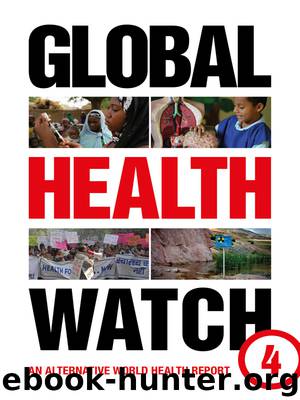Global Health Watch 4 by Global Health Watch

Author:Global Health Watch
Language: eng
Format: epub
Publisher: Zed Books
Published: 2014-06-14T16:00:00+00:00
In contrast, Fiji has been able to intervene effectively by banning mutton and lamb flap sales (see Box C3.2).
Conclusion
While they cannot claim to be representative of the whole spectrum of global nutrition and food security, these two case studies individually and together illustrate the complex and dynamic global food and nutrition crisis. They are stark reminders of the urgency of eliminating the ‘double burden of nutrition’, and of the clear and distressing explications of its national and global social, economic and political contexts. They underline the fact that this human crisis cannot be addressed without confronting and changing its social determinants.
The India case study demonstrates, inter alia, the paradox of national food sufficiency and simultaneous widespread hunger and under-nutrition. While food is available within the country, it is clear that access to this food is dangerously limited for a very significant proportion of the population as a result of trade policies often influenced by a global environment inimical to national food sovereignty, and international advice that promotes current economic orthodoxy. Both of these policy thrusts have resulted in large stockpiles of food, but at the same time high food prices and unaffordable agricultural input costs.
The Pacific region case study demonstrates clearly how national food sovereignty and nutrition security have been undermined by the promotion of ‘free’ trade in the region, resulting in the Pacific Islands (along with an ever-increasing number of other countries) becoming a net food importer. This has resulted in a decline in national food production and in a rapid change from a more traditional and healthier diet to one that is obesogenic, consisting largely of fatty meat and ultra-processed, packaged foods.
Acknowledgements
The case studies benefited greatly from interviews and personal communications with S. Kannaiyan, Sachin Kumar, Deepa Sinha, Anuradha Talwar, Vijoo Krishnan, Suneet Chopra, Utsa Patnaik, Afsar Jafri, Abhijit Sen, Jayati Ghosh and Veena Shatrugna.
Notes
1 This chapter draws on a background paper prepared for The Lancet – University of Oslo Commission on Global Governance for Health Report, www.med.uio.no/helsam/english/research/global-governance-health/background-papers/food-sovereignty.pdf.
2 For more on the debates about India’s calorie intake norms and data, see Patnaik (2007b).
3 Large-scale economic reforms in India were initiated in July 1991 as a response to the external debt and foreign exchange crisis. This represented an acceleration of a process that had started in the 1980s and which constituted a departure from the post-independence model of planned development. While not formally termed a structural adjustment programme dictated by IFIs, the neoliberal economic reforms, which continue to this day, had most or all of the characteristics of SAPs that were implemented in large parts of Latin America and Africa.
4 For more details on trends in price variations, see Patnaik (2005).
5 Rain-fed agriculture accounts for around 56 per cent of India’s total cropped area, 77 per cent in the case of pulses, 66 per cent for oilseeds and 45 per cent for cereals
6 Jayati Ghosh, economist, personal interview, 29 December 2012.
7 Personal communication, August 2012.
8 Personal communication, February 2012.
References
ADB (Asian Development Bank) (2008) Living with High Prices: A Policy Brief, Philippines: Pacific Studies Series.
Download
This site does not store any files on its server. We only index and link to content provided by other sites. Please contact the content providers to delete copyright contents if any and email us, we'll remove relevant links or contents immediately.
| Epidemiology |
Good by S. Walden(2910)
The Social Psychology of Inequality by Unknown(2304)
0041152001443424520 .pdf by Unknown(2214)
The Checklist Manifesto by Atul Gawande(2199)
The Meaning of the Library by unknow(2064)
23:27 by H. L. Roberts(1889)
Guns, Germs and Steel by Diamond Jared(1876)
Being Mortal: Medicine and What Matters in the End by Atul Gawande(1803)
Borders by unknow(1779)
A Leg to Stand On by Oliver Sacks(1709)
The Hot Zone by Richard Preston(1630)
And the Band Played On by Randy Shilts(1612)
The Valachi Papers by Peter Maas(1512)
The Obesity Epidemic by Robyn Toomath(1419)
The Laws of Medicine by Siddhartha Mukherjee(1411)
The Andromeda Strain by Michael Crichton(1362)
The Plague and I by Betty Macdonald(1264)
Pharmacy Practice and The Law by Richard Abood(1252)
Autism's False Prophets by Paul A. Offit(1237)
